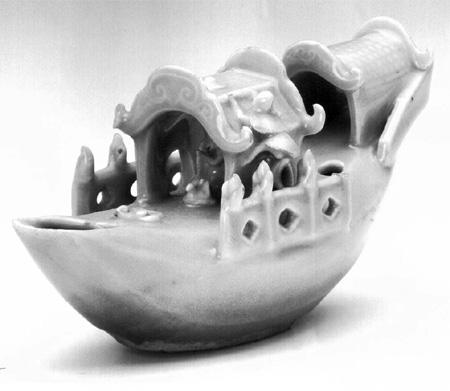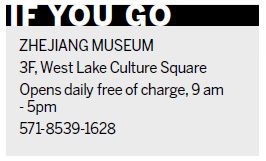Tips and Articles
Paid for in bowls
Updated: 2011-07-24 06:24
By Zhang Kun (China Daily)

Museum curators in Zhejiang use the oddest currency. They go about the countryside armed with sets of new crockery to exchange for ancient bowls and dishes. Zhang Kun has the story.
In an age when there were no antique markets in China, museum staff used to cycle out to the countryside of Zhejiang province loaded with new bowls and dishes. They would exchange these for antiques from the villagers.
It was in the early 1960s when a peasant woman found an odd-shaped ceramic item in the ruins of an old kiln in Shangyan'er, Longquan of Zhejiang province. Without second thoughts, she gave it to the local museum.
This odd object, a boat-shaped celadon water dropper, soon won acclaim from ceramics scholars all over China. It was recognized as one of the representative pieces of Longquan Kiln and went from the museum of city of Wenzhou to that of Zhejiang province.
In 1993, when the Zhejiang Museum sent its collection of antique celadon for an exhibition in Hong Kong, this piece had the highest insurance premium.
In 1999, when the Zhejiang Museum celebrated its 70th anniversary, a limited edition of replicas was made and now the celadon water dropper is one of the most treasured pieces among the museum's collections.
Last year, Professor Cai Naiwu of the Zhejiang Museum was in Longquan to help locals authenticate their collection of antiques, when an old woman came up to him. It turned out she was the woman who found the treasured celadon water dropper.
"No she didn't take any reward for that," Cai told China Daily. "In those years, antiques were part of 'sijiu' - and people would secretly throw out old things for fear of being known to be in possession of such."
Posijiu or Break the Four Olds - old ideology, old culture, old habits and old customs - was the name of a national campaign 1960s that sought to eliminate obsolete culture.
"We used to get antique dishes and bowls in exchange for new ones we brought along," Cai said. "Sometimes we gave two or three in exchange for one old dish. You cannot imagine it now, but that was how we collected antique ceramics for the museum."
The celadon water dropper came from the Southern Song Dynasty (1127-1279), a period when the Longquan Kiln was at its pinnacle. The craft of firing celadon was fully matured then, and the potters had mastered the art of the most beautiful jade-green glaze.
The Chinese started to build kilns and make ceramics in Longquan in the Song Dynasty (960-1279). When the emperor surrendered his capital of Kaifeng in Henan province to invaders from the north, he moved to Hangzhou in 1127, marking the start of the Southern Song era (1127-1279). With the move came the transfer of the technology and craft of ceramic making to the Yangtze Delta, and the Longquan Kiln. Even so, a water dropper is a rare find.
It is shaped like a small delicate teapot, and is used to deliver drops of water to the ink-stone to make the grinding of the ink tablet easier. They are often intricate, and also smart. A tiny hole bored into the side near the handle allows the user to control the amount of water coming out of the spout - an important detail to control the viscosity of the ink used for painting and calligraphy.
These water-droppers are usually custom-made, normally for an intellectual, scholar or artist. They would be designed by the user, and then sent for crafting and firing.
"That's the reason why no similar pieces were ever found, no repeated shapes or designs from water droppers produced by the Longquan kilns in the Song and Yuan Dynasties," Cai said.
Our celadon water dropper is 16.7 centimeters long, 6.5 centimeters wide and 9.3 centimeters tall. It's in the shape of a small boat - probably inspired by the kind found in the Yangtze Delta. The cabin is shaped like a pagoda, and two figures sit side by side as if in intimate conversation. A small shelter can be seen, but the boatman is not resting. Instead he is standing by the side of the cabin, reaching high for his hat on top.
"The details make it very difficult to glaze and it's an even greater challenge to sculpt the piece and combine figurative details with abstract imagination there is no doubt it represents the best of ceramics from the Song Dynasty," Cai wrote in an essay published in Cultural Relics of the East.
"It was not unearthed from the grave of a high-ranking official or royal family, nor was it from the privileged collection of the Imperial Palace," Cai said. "It embodies the achievement of art and civilization of ancient China. No wonder it is one of the top 10 treasures of the Zhejiang Museum."
You can contact the writer at zhangkun@chinadaily.com.cn.

(China Daily 07/24/2011 page15)

Specials

Turning up the heat
Traditional Chinese medicine using moxa, or mugwort herb, is once again becoming fashionable

Ciao, Yao
Yao Ming announced his retirement from basketball, staging an emotional end to a glorious career.

Financial sector short of talent
Lack of skilled professionals in Shanghai inhibiting the city's development as a financial hub